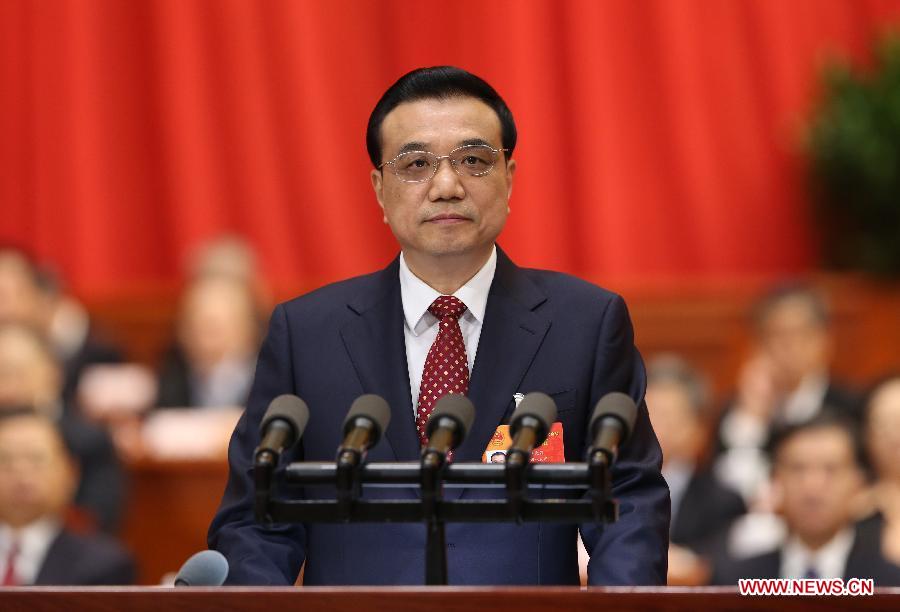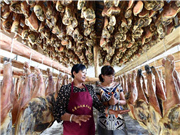


Chinese PremierLi Keqiangdelivers the government work report during the opening meeting of the third session of China's 12th National People's Congress (NPC) at the Great Hall of the People in Beijing, capital of China, March 5, 2015. (Xinhua/Huang Jingwen)
BEIJING, March 5 -- China lowers its economic growth target in 2015, but aims to achieve better-quality growth, as the government is endeavoring to maintain a proper balance between ensuring steady growth and making structural adjustments, Premier Li Keqiang said Thursday.
The world's second largest economy targets its growth of approximately 7 percent in 2015, lower than the goal of around 7.5 percent in 2014, according to a government work report delivered by Li at the parliament's annual session.
The growth target for 2015 is also lower than the 7.4-percent economic growth rate registered in 2014, its weakest annual expansion since 1990.
"Over the past year, the international and domestic environments faced by China in its development have been complicated and challenging. The road to global economic recovery has been rough, with many ups and downs, and the performance of the major economies has been divergent," Li said.
"Downward pressure on China's economy has continued to mount, and we have faced an array of interwoven difficulties and challenges," he added.
In the 35 years between 1978 and 2013, annual growth of the Chinese economy averaged close to 10 percent. However, the "good old days" had to end, with growth decelerating to 7.7 percent in 2012 and 2013.
The target growth rate of approximately 7 percent "takes into consideration what is needed and what is possible. This target is both aligned with our goal of finishing building a moderately prosperous society in all respects and is appropriate in terms of the need to grow and upgrade our economy," Li said.
"If China's economy can grow at this rate for a relatively long time, we will secure a more solid material foundation for modernization," he added.
To aid the economic growth, China will continue to implement a proactive fiscal policy and prudent monetary policy this year, noting policy flexibility.
Stressing the proactive fiscal policy will serve to "sustain the momentum of economic growth and increase economic returns," the country will raise its budget deficit to 2.3 percent of its gross domestic product (GDP) for 2015, up from last year's target of 2.1 percent.
The broad money supply, or M2, is forecast to grow by around 12 percent this year, lower than the target of around 13 percent of 2014, but the actual money supply may be "slightly higher than this projection depending on the needs of economic development," noted the report.
"The aim of maintaining stable growth is to ensure employment. As the service sector becomes larger, the number of small and micro businesses grows, and the economy gains in size, a growth rate of approximately 7 percent will ensure ample employment," Li said.
China aims to create more than 10 million urban jobs and ensure that the registered urban unemployment rate does not rise above 4.5 percent in 2015.
"We must focus on achieving the dual objectives of maintaining a medium-high-level growth rate and moving toward a medium-high-level of development," Li told Chinese lawmakers.
It was the first time that an important official document features the double "medium-to-highs." The report, which was delivered to the parliament for examination, said China needs to rely on both the traditional and new engines of growth.
"We need to develop twin engines to drive development: popular entrepreneurship and innovation, paired with increased supplies of public goods and services," it noted.
China will invest more than 800 billion yuan (130 billion U.S. dollars) in railway construction in 2015, and meanwhile, the investment in the major water conservancy projects under construction will exceed 800 billion yuan this year.
Day|Week

 Tsinghua junior makes over 10,000 yuan a day by selling alumnae's used quilts
Tsinghua junior makes over 10,000 yuan a day by selling alumnae's used quilts Graduation photos of students from Zhongnan University
Graduation photos of students from Zhongnan University A school with only one teacher in deep mountains
A school with only one teacher in deep mountains Glimpse of cultural heritage "Xilankapu"
Glimpse of cultural heritage "Xilankapu" Homemade cured hams in SW China
Homemade cured hams in SW China Breathtaking buildings of W. Sichuan Plateau
Breathtaking buildings of W. Sichuan Plateau Graduation photos of "legal beauties"
Graduation photos of "legal beauties" Top 10 most expensive restaurants in Beijing in 2015
Top 10 most expensive restaurants in Beijing in 2015